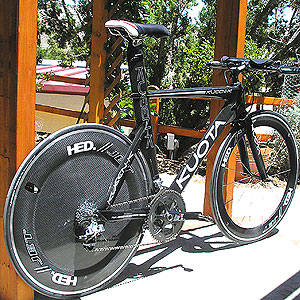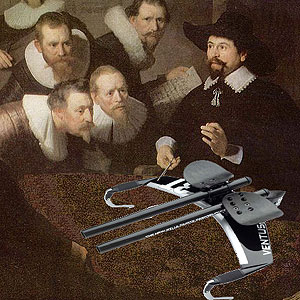Valdora—lay your body down
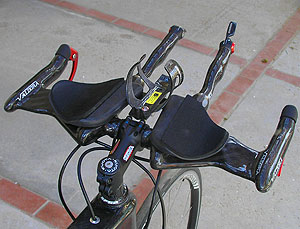
It was not that many years ago that the aerobar market was hamstrung by lack of innovation and choice. It wasn't that no one had a bright idea, rather that everyone was put off by the threat of patent litigation—Scott and Profile Design fought a bitter and expensive legal battle through the early 1990s.
Syntace bought a license from Scott, Visiontech successfully thumbed its nose at the patent, and Hed jumped in with its own bar just after the turn of the decade. By this time Scott's patent had either run out or was close to expiring, and the race was on. Since then, many innovative aerobar designs have come to market.
Now we probably suffer from the other extreme: too many aerobar designs for the market to absorb. Nevertheless, I'm always curious to see what's out there. Just under a year ago I passed by a small booth at Interbike inhabited by Valdora Cycles. Its bikes are nice. But the aerobar stole my attention. A couple of weeks ago my Valdora SR-1.0 arrived.
While there are a few integrated-stem bars that aren't too bad—I quite like 3T's Ventus—I prefer the bar to be stem-free, mostly because I want to choose the stem length I want, and because I want to pitch the bars to my preference. The SR-1.0 gives me the stem-free feature I like.
I outfitted the bars with SRAM Red bar-end shifter and brake levers. The aerobar's pursuit bar O.D., where you plug in the brake levers, is a bit big for the SRAMs, so you'd have to shim them to get a snug fit. The shift levers, though, couldn't be a better fit. It's like SRAM's levers and Valdora's extensions were made to be sub-assemblies of the same finished product.
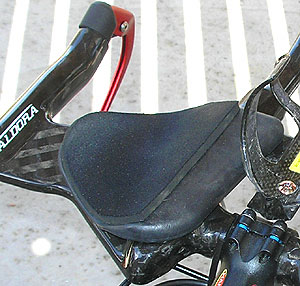
What first interested me when I initially saw this aerobar was its plush armrests. Valdora Cycles has done a great job of figuring out how to get the rider's forearm on top of a lot of surface area, while cutting off the back of the armrest into which your knee and mine would smack when we're out of our saddles. That said, the armrest trough is cantilevered, and I needed a little something to stiffen it up. Those little arc-shaped shifter fittings Shimano makes to put cable casing ends onto downtube shift bosses? After I ground off a little metal I slid one between the pursuit bar and each armrest. They physically can't come out of there, and it stiffened the armrests nicely.
The extensions are ergonomically superior to the touch, if it's an S-bend shape you want. It's very close to the Profile Design Cobra extension, and both Valdora and Profile really know how to make an S-bend. The extension slides into a collet system, just like the style Zipp uses on its Vuka bar.
The problem is this: the SR-1.0 allows for no wiggle room in extension width, and these extensions sit pretty far out from each other. You'd have to like that in order to like these bars. Otherwise, you'll need to put another set of extensions in there. Unlike the Vuka, you can do that with this aerobar. Just as I slid a set of Blackwell Wrist Relief extensions into the 3T Ventus and "perfected" it (to my taste), some of you may want to slide a different set of extensions into the SR-1.0.
Should you like the included extensions, they are factory-made quite long, just in case you have Dennis Rodman-length arms. You simply cut the back of the extensions to length, and stick them into the colleted sockets.
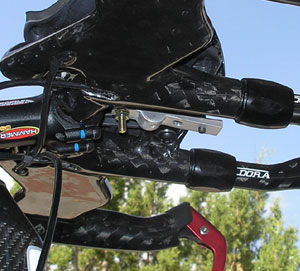
As with everything on this bar, the pursuit ergonomics are fabulous. When you're out of the aero position, the extensions feel great on the hands. The pursuits are not pitched way in front of handlebar clamp, as is the case with many pursuit bars today, making an impossibly long steering lever and pitching your weight well over the bike's CG. Again like Zipp's Vuka, this pursuit contact point is further back, akin to having one's hands on the hoods of a road bike.
One thing to note about the SR-1.0: it's a very low-profile aerobar, that is to say, the lowest point of the armrest surface sits about 20mm above the centerline of the handlebar clamp (where the pursuit bar passes through the stem). This is a record breaker. I've never measured anything with a profile this low. The Hed one-piece has its armrests 25mm above the stem clamp center. Consider this before you replace a Syntace or Profile aerobar with this one. Such a move will drop you 5cm lower to the ground, unless you've already got a similarly low-down Profile (like the Sonic Stryke).
If you replace a Visiontech clip-on with this bar, your armrests will drop 15mm relative to your saddle, assuming you've got Vision's factory-installed 25mm spacer between the armrest trough and the clamp. As to the difference in elevation between the SR-1.0 and other aerobars, your results may vary. Measure the elevation difference first before you attempt to retrofit with this bar. You don't need to have the SR-1.0 in your possession before you calculate this. I already told you what the armrest elevation is for this bar. Figure out what it is on your existing bar, and then subtract to get the delta. Then figure out how you're going to make this bar fit on your bike, changing around spacers, the stem pitch, and so forth.
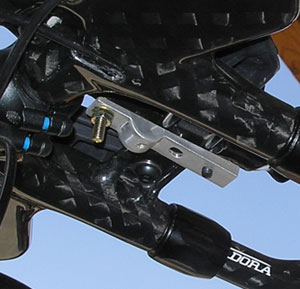
In general, low-profile aerobars work well on bikes with tall head tubes. So, this bar is a good bet on a Scott Plasma, a Cannondale Slice, a Trek Equinox TTX. It is less likely to fit the typical triathlon riding a P3C, a QR Kilo or a Kestrel Airfoil Pro. Of course, you may not be a typical rider. All that said, here's the acid test: do you need to get the front end of your tri bike lower? If so, this is an aerobar you may want to consider. Is your bike already low enough or too low, and you've already got several centimeters of spacers under your stem? Don't get this bar until and unless you're going to make a bike change at the same time.
This bar has a little cross-piece, in front of the stem and between the extensions. Several bars have this, I don't know if it's primarily a structural thing or if it's there to mount your what-nots on. I chose to mount a what-not. If I'm going to ride an aero bike, I want to give the frame at least a fighting chance to be aero. So, I get all the bottles off of it. I like to place one bottle between the aerobars. Profile Design makes a piece to retrofit a Carbon X with a lower-profile armrest, and this piece worked very nicely as a mount that spans the underside of this Valdora bar's what-not hanger.
The SR-1.0 is all 12K carbon, and at $750 is not inexpensive. Were I a retailer, I'd absolutely stock this bar in my shop. I'd buy it complete from Valdora, but would immediately separate the bar from its extensions, the latter of which are very nice and would work with any bar made to use 22.2mm O.D. Extensions. I'd figure out what extensions may be the best solution for narrower hands while in the aero position, and offer this to my customers as an option. This is a bar that ought to be on a lot of bikes in transition areas.


